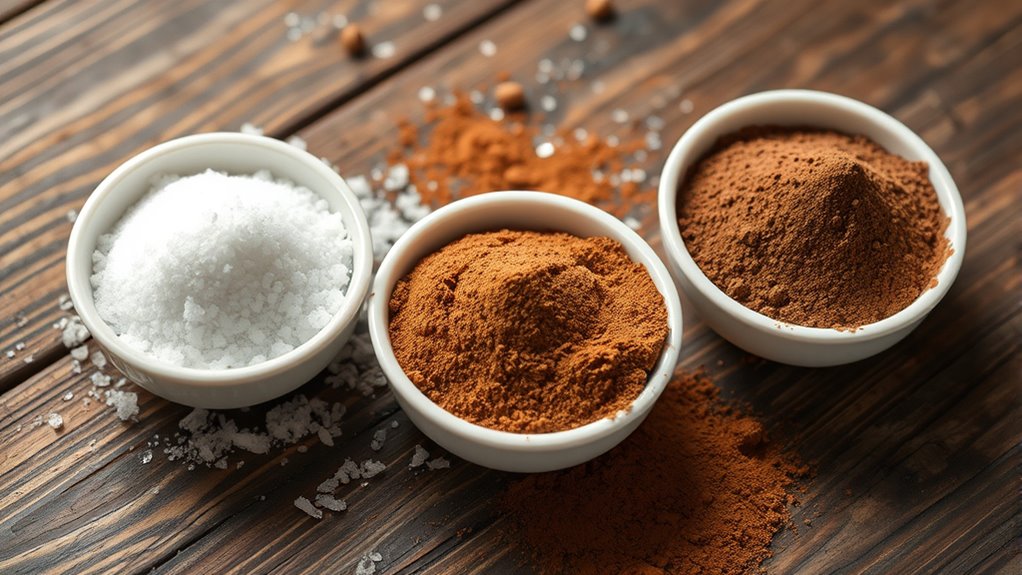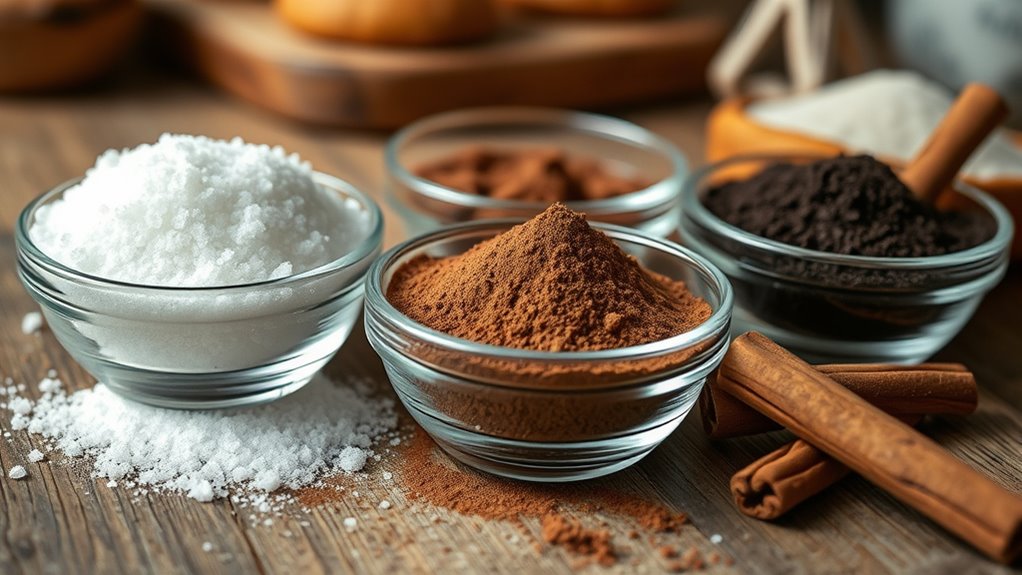Using sugar, cocoa, and cinnamon as pizza toppings sparks a lively debate, challenging the idea of sticking to traditional flavors. You might find these ingredients evoke comfort and cultural heritage, yet they push culinary boundaries. Chefs experiment with these toppings to blend sweet and savory, inspiring creative fusion. Considering health impacts and cultural significance adds complexity to the conversation. Curious how these ingredients continue to influence pizza innovation? Keep exploring to uncover the flavorful possibilities.
Key Takeaways
- Sugar, cocoa, and cinnamon evoke cultural traditions while challenging conventional pizza toppings.
- Chefs experiment with these ingredients to blend sweet and savory flavors creatively.
- These toppings honor cultural heritage but raise health concerns related to sugar and fat content.
- Cinnamon holds cultural significance in Middle Eastern and Mediterranean cuisines, enriching flavor diversity.
- Balancing tradition, innovation, and health considerations shapes ongoing debates about their use on pizza.

Traditional pizza toppings like pepperoni, mushrooms, and olives have long defined classic pies, but recent debates question whether sticking to tradition limits creativity. When it comes to toppings like sugar, cocoa, and cinnamon, the discussion takes on a different flavor—one that touches on cultural significance and health implications. These ingredients, often associated with desserts, are increasingly used on pizza, sparking conversations about whether such combinations are innovative or just unusual. For many, sugar, cinnamon, and cocoa evoke nostalgic comfort, rooted in cultural traditions from various regions. Cinnamon, for example, holds deep cultural importance in Middle Eastern and Mediterranean cuisines, often used in sweet and savory dishes alike. Adding it to pizza can be seen as a way to honor tradition while experimenting with flavor profiles. Similarly, cocoa and chocolate have long been linked to celebrations and special occasions in numerous cultures, making their inclusion on pizza feel like a nod to heritage. Interestingly, some chefs explore creative flavor pairings using these ingredients to challenge conventional pizza expectations. However, integrating these sweet toppings into a typically savory dish also raises questions about health implications. Sugar, when added liberally, can considerably increase the calorie content of the meal and contribute to health issues like obesity and insulin resistance if consumed excessively. Cocoa, especially in the form of chocolate, contains fats and sugars that might balance flavor but also challenge nutritional balance. Cinnamon, on the other hand, is often praised for its potential health benefits, such as anti-inflammatory properties and blood sugar regulation, making it a more favorable addition. But even so, the overall nutritional impact depends on the quantity used and the context of the rest of your diet. The debate isn’t just about flavor; it’s about how cultural significance and health implications influence culinary choices. Using sugar, cocoa, and cinnamon on pizza can be a way to pay homage to cultural roots and explore new taste experiences. Still, it’s essential to weigh health implications—especially if you’re mindful of sugar intake or managing health conditions. For some, these toppings represent a creative evolution, blending sweet and savory elements to push culinary boundaries. For others, they challenge traditional notions of what pizza should be, raising questions about authenticity and health. Ultimately, incorporating sugar, cocoa, and cinnamon into pizza is a personal choice that involves balancing cultural appreciation with health awareness, reflecting how food continues to evolve while respecting its roots.
Frequently Asked Questions
Are There Regional Preferences for These Toppings Worldwide?
Yes, you’ll notice regional flavor preferences influence how people top their desserts worldwide. In some areas, cultural topping traditions favor cinnamon for its warm aroma, while others prefer cocoa for a richer taste or sugar for sweetness. These preferences reflect local tastes and culinary heritage, making each region’s toppings unique. So, when you enjoy a sweet treat, consider how regional influences shape those flavor choices, adding cultural depth to every bite.
How Do Toppings Impact the Nutritional Value of Desserts?
Toppings are like sprinkles of health and indulgence, shaping your dessert’s nutritional story. They can boost calorie content considerably, turning a light treat into a calorie-heavy indulgence. While some toppings add to nutrient density with antioxidants or vitamins, others mostly provide empty calories. Choosing wisely lets you enjoy flavor without sacrificing nutritional value, balancing indulgence with your health goals.
Can Toppings Be Used to Enhance Flavor Without Extra Sugar?
Yes, you can use toppings to enhance flavor without adding extra sugar. Opt for natural flavor enhancement by using health-conscious toppings like fresh fruit, nuts, or spices such as vanilla or ginger. These options boost taste while keeping your dessert nutritious. By choosing such toppings, you satisfy your craving for flavor without compromising your health goals, making your treats both delicious and nourishing.
What Are Some Alternative Toppings for Those With Allergies?
Think of your toppings as a colorful palette—there are many safe options for allergies. You can try gluten-free granola, fresh fruit, or seeds like chia and hemp. Dairy-free alternatives such as coconut flakes, nut butters, or dairy-free yogurt can add flavor and texture. These options keep your treat safe and delicious without risking allergic reactions, making every bite both enjoyable and worry-free.
How Do Cultural Traditions Influence Topping Choices?
Cultural traditions heavily influence your topping choices by shaping what symbols and flavors hold significance. You might choose toppings rooted in cultural symbolism, reflecting history and beliefs, or follow traditional preparation methods passed down through generations. These practices guide you to select ingredients that honor your heritage, creating a meaningful connection during meals. Your preferences are a blend of cultural identity, history, and the desire to preserve traditional flavors and symbolic meanings.
Conclusion
As you sprinkle sugar, cocoa, or cinnamon atop your favorite treat, remember each topping paints a different flavor story. The gentle crunch of sugar, the rich aroma of cocoa, or the warm whisper of cinnamon—all evoke memories and preferences unique to you. In this colorful tapestry of toppings, it’s your palate’s dance that truly matters. So, embrace your choice, savor the moment, and let your taste buds guide your next delightful bite.









